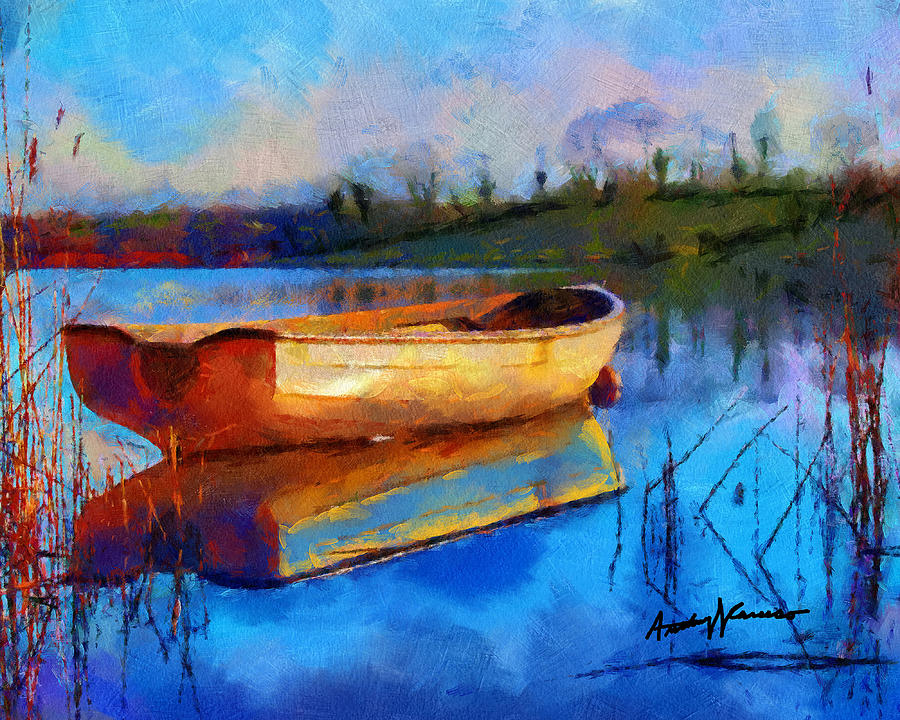- Rayleigh Scattering is what makes the sky blue.
- The sun's effect on clouds is different when you look towards versus away from the sun.
- From the towards the point of view, light shines around the edges of the clouds, almost outlining them with light.
- From the away point of view, light falls more evenly on the surface of the clouds, making them look like the clouds we usually think of and get darker towards the bottom. Small clouds are not as dense as large clouds so they are more opaque.
- One way to learn about the color of the sky is to use paint swatches from a store or a mirror to reflect the color of the sky. You can match the best color to the color of the sky.
- The sky will get lighter as it gets towards the sun, from the solar glare, and darker/more saturated away from the sun. In addition, the horizon is lighter than the open sky.
- Overall, you will need four starting colors to paint the sky.
- Atmospheric Perspective

- Things in the distance are obscured from the viewer by the illuminated air in between. The objects will eventually blend in closely with the sky, becoming more blue and light.
- Distant silhouettes blend together and lose clarity as they fade away.
- White objects in atmospheric perspective will grow in warmth. Clouds and sunsets become bright orange and red. This phenomenon only occurs when the air is clear and illuminated by the light.
- When moisture is added to he air, like by a waterfall or river, the tones are lightened and warmed.
- Reverse Atmospheric Perspective
- In some instances, the light becomes warmer further back into the scene. When dust or moisture lingers in the area of the sunlight, the light catches on the particles and scatters.
- This kind of lighting conveys a sense of strangeness or excitement.
- Golden Hour Lighting
- Golden hour is a short period of time at dawn and dusk in which natural colors are enhanced by the sun's light, which comes tangent onto the earth's surface and illuminates the things in its path.
- The light has further distance to travel, and so releases more light, making colors richer.
- Sunsets
- Sunsets can be hard to capture because there are many layers of air that the light interacts with on its way to the surface. When the sky has lots of moisture, pollution, or dust, the sun will make bright red and yellow colors as it sets. After the sun has set, a layer of grey color rises up where it went down.
- Clouds catch light on the underside because the light. Clouds closer to the sun will be a brighter color and those higher will be closer to white.
- Fog, Mist, Smoke, Dust
/https://public-media.si-cdn.com/filer/0c/f9/0cf93517-a588-48cb-a067-b5d0765e294d/turner_sunset_painting.jpg)
- In any of these conditions, the light is scattered by the particles in the air. It isn't able to directly reach the ground, so it bounces around and can come from anywhere. Thus, extreme contrast is dimmed.
- Rainbows

- Rainbows are a result of light refracting through the rain. Rainbows don't grow or diminish in size with distance since they are only created by the angle that the viewer is seeing the light. If there are two rainbows, the second rainbow's colors are reversed because it bounces twice through the raindrops.
- When painting a rainbow, the rainbow colors will always be lighter than their background because of the extra light.
- Sunbeams and Shadowbeams
- In dusty or moisture-laden air, sunbeams and shadowbeams are likely to appear. Sunbeams only happen in specific conditions:
- 1. A layer of clouds, foliage, or architecture has only a few openings.
- 2. Air is filled with smog, dust, or smoke.
- 3. The perspective is looking at the sun.
- Sunbeams usually make shadows on a form much darker and the light a little lighter. Sunbeams and shadowbeams should only be used every once in a while, as they catch a lot of attention
- Dappled Light
- The light that falls through the leaves will be different sizes or shapes depending on the foliage above. When a shape falls onto a surface that isn't flat, it will spread out.
- Cloud Shadows
- Clouds sometimes interrupt the light from the sun. This can be helpful to direct the viewer's attention.
- Do not transition from sun to shadow too quickly, and make sure that the clouds match the shadows.
- Illuminated Foreground
- When you illuminate the foreground of a painting it is inviting the viewer to look there.
- Snow and Ice
- Snow is able to pick up more color than clouds or foam, so shadows are also going to pick up more color. As snow gets older, it gets darker and denser, making it shinier.
- Water: Reflection and Transparency
- Water is only especially reflective when you look at it straight across at a very shallow angle. When you look down on the surface of the water, not much light reflects back up to you. The reflections of light objects in the water will be darker than the actual object because some of the light will travel through the surface of the water instead of bouncing off.
- Color Underwater
- Water filters out color that passes through it. When you get deep enough, the only colors that remain are violet and blue.








